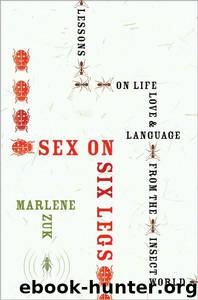Sex on Six Legs: Lessons on Life, Love, and Language From the Insect World by Marlene Zuk

Author:Marlene Zuk
Language: eng
Format: mobi
Tags: Science, Non-fiction
ISBN: 9780151013739
Publisher: Houghton Mifflin Harcourt
Published: 2011-07-20T00:00:00+00:00
Boys Will Be Girls Will Be Boys, Naturally
PEOPLE sometimes conclude from this kind of work that the damselflies, or Gillespie's spiders, or any of the other insects and their kin observed in homosexual pairings are making a mistake, and therefore human homosexuals are likewise in error, some kind of evolutionary fluke. Interestingly, a National Geographic story on Van Gossum's study suggested, "Such flexibility may also lead to genuinely homosexual damselflies." This implies, I suppose, that the damselflies in the Belgian experiments were somehow not really gay, although it's hard to know what the litmus test might be.
Instead, I think it makes more sense to see the flexibility in mating behavior, same-sex courtship and all, as part of the animals' natural repertoire. We cluck disapprovingly over the males' supposed errors, but that represents our misunderstanding of how evolution works. François Jacob famously said that nature is a tinkerer and not an engineer. What he meant was that natural selection doesn't produce perfection; it produces traits that are good enough. We often think of this in connection with our bodies, so that we have spines that are not really adapted to walking upright or immune systems that sometimes overreact to give us allergies to harmless substances, but the slop is part of every system, including behavior.
The chrysanthemum longicorn beetle (Phytoecia rufiventris) is a lovely insect with a ruby red spot on its back and a rust-colored abdomen. It is a pest of chrysanthemums, as the name suggests, and a single female can kill as many as seventy plants by laying her eggs in the stems, which makes understanding the beetles' biology of interest to horticulturalists. Unlike many insects, the chrysanthemum beetle lacks sex pheromones, those come-hither odors often employed as long-distance mate attractants and sex identifiers. The sexes find each other in the first place because both males and females are attracted to plants of a certain height. Qiao Wang at Massey University in New Zealand and his coworkers discovered that the male beetles reacted similarly to males and females when they first encountered them on a plant stem by attempting to copulate. After the male mounts, he engages in a rather complicated and lengthy probing with his abdomen until he can touch a tiny segment of abdomen of the beetle underneath him, and it is only at that point that he can determine whether he has mounted a male or a female. Eventually he disengages from an individual found to be another male, but Wang and his colleagues suggest that "males may 'waste' a lot of time during their reproductive life."
But time wasted is in the eye, or maybe the pheromone glands, of the beholder. Sure, if the beetles had a more foolproof way to determine who was who, they would have more time to feed, or hide from predators, or do crossword puzzles for that matter (what's a nine-letter word for "life-destroying chemical"?). Similarly, if human beings had pelvic girdles that could more easily accommodate a full-term fetus, childbirth would
Download
Sex on Six Legs: Lessons on Life, Love, and Language From the Insect World by Marlene Zuk.mobi
This site does not store any files on its server. We only index and link to content provided by other sites. Please contact the content providers to delete copyright contents if any and email us, we'll remove relevant links or contents immediately.
| Amphibians | Animal Behavior & Communication |
| Animal Psychology | Ichthyology |
| Invertebrates | Mammals |
| Ornithology | Primatology |
| Reptiles |
Sapiens: A Brief History of Humankind by Yuval Noah Harari(14248)
The Tidewater Tales by John Barth(12608)
Mastermind: How to Think Like Sherlock Holmes by Maria Konnikova(7225)
Do No Harm Stories of Life, Death and Brain Surgery by Henry Marsh(6887)
The Thirst by Nesbo Jo(6826)
Why We Sleep: Unlocking the Power of Sleep and Dreams by Matthew Walker(6618)
Life 3.0: Being Human in the Age of Artificial Intelligence by Tegmark Max(5474)
Sapiens by Yuval Noah Harari(5293)
The Longevity Diet by Valter Longo(5018)
The Body: A Guide for Occupants by Bill Bryson(4974)
The Rules Do Not Apply by Ariel Levy(4856)
The Immortal Life of Henrietta Lacks by Rebecca Skloot(4525)
Animal Frequency by Melissa Alvarez(4394)
Why We Sleep by Matthew Walker(4359)
The Hacking of the American Mind by Robert H. Lustig(4318)
Yoga Anatomy by Kaminoff Leslie(4303)
All Creatures Great and Small by James Herriot(4231)
Double Down (Diary of a Wimpy Kid Book 11) by Jeff Kinney(4206)
Barron's AP Biology by Goldberg M.S. Deborah T(4096)
